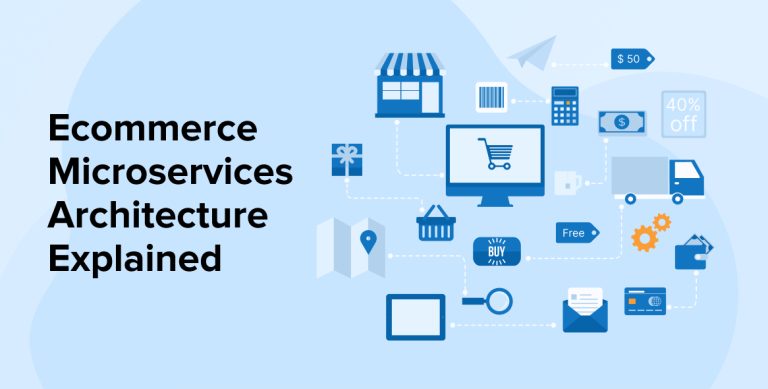
E-commerce microservices allow e-commerce development services or companies to abandon the inflexible, comprehensive monolithic architecture that makes it challenging, if not impracticable, to adapt quickly to shifting customer buying habits, standards, and the requirement for consistent experiences across all channels.
We define e-commerce microservices-based architecture, highlight a few of the primary advantages and challenges, and show how it might help you.
1. What are Microservices?
Microservices represent compact-sized programs designed for specific purposes. In other words, they are small components of a larger software system architecture, allowing for easy modification, independent development, and implementation.
Microservices cooperate to accomplish the tasks of a solitary program more effectively. It describes a way of organizing software in which each program acts as its own standalone service.
One of the many implications of microservice-based architectures for eCommerce is their ease of composition into scalable systems. Because of its modular design and simplicity of deployment, the microservices architecture helps enterprises avoid the scaling problems that come with monolithic systems.
Further Reading on: Monolithic vs Microservices Architecture
2. What are Microservices in E-Commerce?
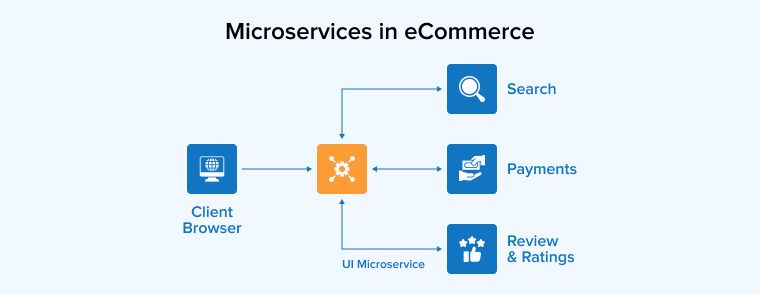
In the world of online shopping, the word “microservices” refers to a certain type of program design. Each service gives the program a different purpose. You can run these API-based tasks by themselves or together. Businesses can change and expand the base on which they build these microservices to meet their specific needs.
Microservice-based e-commerce allows developers to implement better features to the backend in a progressive approach by adding new services that may run separately from one another. The ability to add new services on demand and continue building upon an existing foundation makes the system resilient to change.
Product inventory management, handling orders, billing and collection, and delivery logistics are just a few examples of the granular business tasks supplied by these many services. In this scenario, the front end would make a request, the order handling microservice would handle every detail from order verification to making a payment, and the order data would be sent to the delivery logistics microservice for execution.
3. Why Microservice Architecture is used for E-Commerce
Microservice-based design fits any proficient business that needs to handle multiple processes and functionalities all at once. This method can address several issues in e-commerce.
3.1 High Traffic and Data Volume
Online stores process massive amounts of information and user traffic. A typical instance is Black Friday, wherein ecommerce systems need to continue with hundreds of orders in parallel. Rapid scalability is essential in these circumstances. The e-commerce capabilities of a cloud-based microservices architecture can be scaled up or down without affecting non-scalable components. The entire operation is accelerated by this capacity.
3.2 Control Over Every Feature
The management method involves regulating pieces of a system rather than monitoring a single feature since several components rely on one another, like product descriptions, handling payments, and more. Microservices allow for the development, testing, and maintenance of every part separately. This makes the system simple to administer and virtually immune to failure.
Further Reading on: Microservices Testing Strategies
3.3 Rapid Enhancements and Additions to Functionality
Maintaining an edge in the market calls for ongoing adaptation and improvement. Microservices-based architecture provides the rapid creation of standalone functionalities and their subsequent updates. Designing a system with discrete, independent components makes it straightforward for the company to add new features as needed.
4. Components of E-commerce Microservices
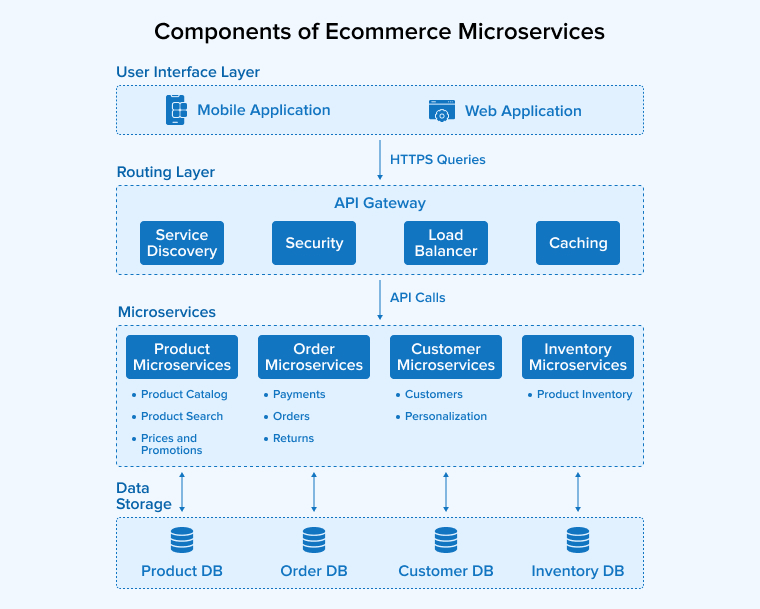
Although the specifics of microservice-based architecture design can differ from company to company, there are a few constants worth noting.
4.1 Interactional UI
End users (such as consumers, stock supervisors, or foreign partners) can utilize the user interface to look for products, add them to their shopping carts, or update the quantity of stock, among other tasks. Developers can use native Android or iOS development tools to create a reliable mobile shopping experience for customers.
4.2 Routing Layers
The user interface sends queries to the routing layer for processing when clients interact. Once the user interface submits a request, it routes it to the relevant microservice or services.
4.3 Microservices
Each microservice is in charge of a different part of the e-commerce system’s operation. For instance, the Blog service is in charge of handling the text of blog posts. A Customer service is another common example of a microservice in an e-commerce system. It handles information about customers and other things. You can use any technology stack to build each microservice that works best for the features you need.
4.4 Databases
Information on items, shipments, payments, and everything else relevant to running an online shop must be stored and accessed by the e-commerce system. The data necessary to carry out e-commerce activities is often maintained in a number of databases. It’s unclear if a single database type or many database types is needed to store the various data formats.
5. Benefits of Microservices for E-Commerce
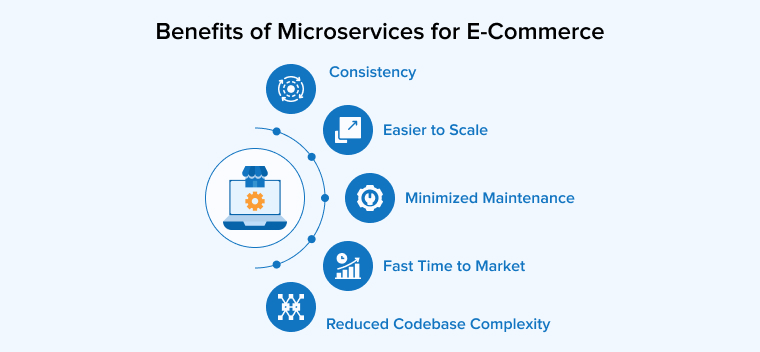
When compared to standard monolithic designs, microservices make it easier for businesses to quickly change and grow their online stores. Businesses can try out new skills, tools, and ways of doing things.
These are some of the many benefits of e-commerce that are based on microservices:
Consistency: Because they are not connected to each other, microservices can be troubleshooted without affecting the rest of the platform. This means more stability because issues with one microservice won’t affect the whole system. You can build, test, and share each microservice on its own without affecting the others.
Fast time to market: You can quickly try out new ideas, methods, and tools with decentralization. It also lets developers work with the systems and languages they desire, instead of confining them to a single system or coding language. That implies you can keep testing and implementing the newest E-commerce functionality without bothering to reassemble everything from scratch.
Easier to scale: The modularity and scalability of microservices are among its primary benefits. A quicker time to marketplace for unique innovations that will set you apart from other businesses is made possible by the flexible “roll out” approach to integrating additional elements and features.
Minimized maintenance: Adding new features takes less time and there is less risk of a system breakdown when services are decoupled. The system as a whole can keep running while the faulty service is investigated, improving its resilience.
Reduced codebase complexity: Microservices, when separated from the rest of the system, facilitate easier updates and maintenance to ensure continuous operation. If you have a monolithic system, all substantial modifications need an overhaul of the whole software. Microservices, which function as mini-systems within a larger system, avoid this problem.
E-commerce built on top of microservices has more adaptability. Businesses may implement the solutions that best suit their requirements in terms of products, offerings, and competencies.
6. Examples of Microservice Architecture for E-Commerce
Many well-known companies across the world are adopting a microservices-modular architecture to be first to market with cutting-edge innovations as the industry shifts. Some companies have taken a decision, and we’ll look at some of them below.
6.1 Netflix
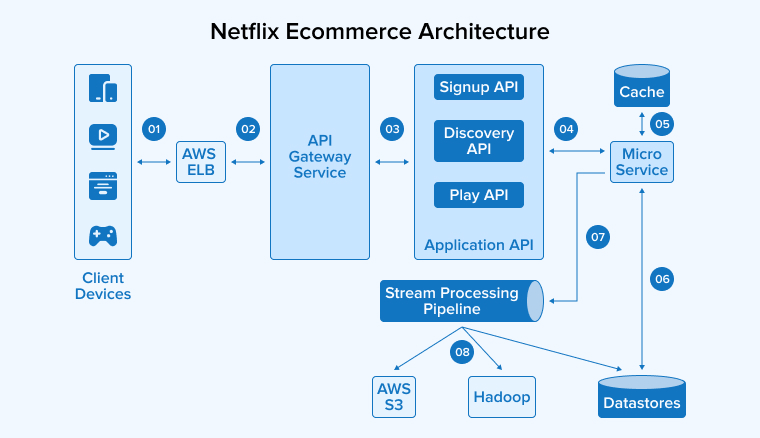
As an early adopter of microservices architecture and cloud infrastructure, Netflix serves as a useful case study for this type of e-commerce. The organization does away with one monolithic program in favor of several smaller ones. They are all designed to function effectively on a large scale and experience minimal downtime. Netflix is able to save money and streamline deployment in this way, allowing the company to put more effort into creating and providing high-quality content and service to its subscribers.
6.2 Gilt
In 2011, Gilt switched to a microservices architecture, at which point it launched more than a hundred new services, redesigned its infrastructure, and reorganized its staff. As a result of the change, it is now simpler to innovate, operate numerous projects simultaneously, accommodate a variety of technologies, and so on.
6.3 eBay
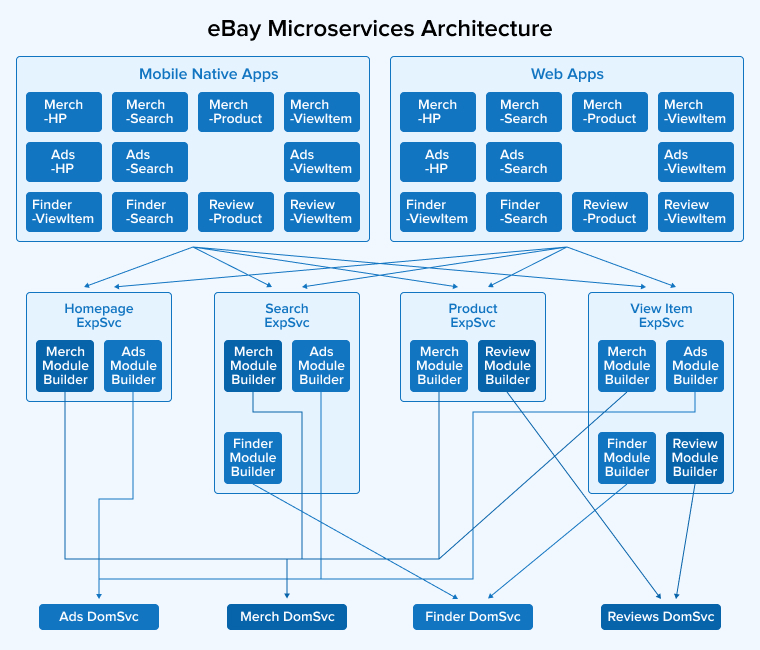
Using microservices, eBay has been able to increase its adaptability, quickness, and resilience since 2011. An abundance of specialized services that handle things like searching, recommending, paying, and shipping. eBay can now freely grow its services, roll out new features rapidly, and increase dependability.
7. E-Commerce Microservices Challenges
Companies face difficulties while transitioning from a monolithic eCommerce system to one built on microservices. After all, depending on a single technology implies that your whole infrastructure, licensing, and organizational framework must revolve around it.
Complete re-platforming of a system that was not originally designed to make use of API gateway and microservices might encounter the following difficulties:
- Worker layoffs and retraining.
- Managing redundant information and links.
- A loss of database authority.
- Adapting your interdepartmental coordination and interaction.
Despite these difficulties, an eCommerce microservices architecture still has many advantages.
8. Should You Adopt an E-Commerce Microservices Architecture?
Businesses in the modern day require an adaptive basis, and microservices ecommerce architecture can deliver that. Developers and end users alike can get the following benefits from using a microservices architecture for ecommerce website:
Microservices architecture has the potential for future commitment after rigorous observation, analysis, and feature analysis. This is because it is redefining the current eCommerce apps and the consumer experience. Let’s take a look at the reasons why you should adopt microservices.
Agility: Developing software systems may go more quickly using microservices approach. Introduce or modify an appropriate application element without disrupting others to cut down months of development time to just several weeks. Eliminate the intricate nature of the integration procedure through this approach.
Efficiency: You can save a ton of money on infrastructure by planning ahead and using code and the underlying infrastructure with care. By utilizing this infrastructure, organizations can cut the cost of running apps by half in certain circumstances.
Resilience: The resiliency offered by microservices architecture is essential in today’s software creation. You’ll have less downtime overall and have more leeway to adapt to changing market demands.
Revenue: Microservices design allows for less downtime, faster iterations, and more scalability, all of which boost income from app development.
9. Conclusion
Microservice architecture is frequently the most effective for growth-oriented e-commerce development methods.
The increasing emphasis on tailoring every aspect of a customer’s interaction with a company, from marketing to sales to support, necessitates a more nimble, scalable, and optimized strategy, TatvaSoft is here for all purposes.
FAQs
What is Microservice Architecture?
The goal of the microservice architecture is to provide scalable, extensible, and adaptable business logic in technology. Release large, sophisticated programs frequently and reliably. A company may also modernize its technological stack with the help of microservice architecture. This facilitates MACH Alliance’s best-of-breed corporate technology ecosystem and paves the way for headless innovations.
What is the Difference Between Monolithic and Microservices for E-Commerce?
When all the features are provided by a single product, we call it a monolithic app. Unlike microservices, you cannot independently scale or update the parts of the application. Because of this, it might be more challenging to make rapid adjustments or grow particular apps.
Why Microservices for E-Commerce?
The flexibility and loose coupling of microservices make it possible to quickly set up and scale the business to suit unique needs. Microservices are the solution to the problems caused by monolithic applications.


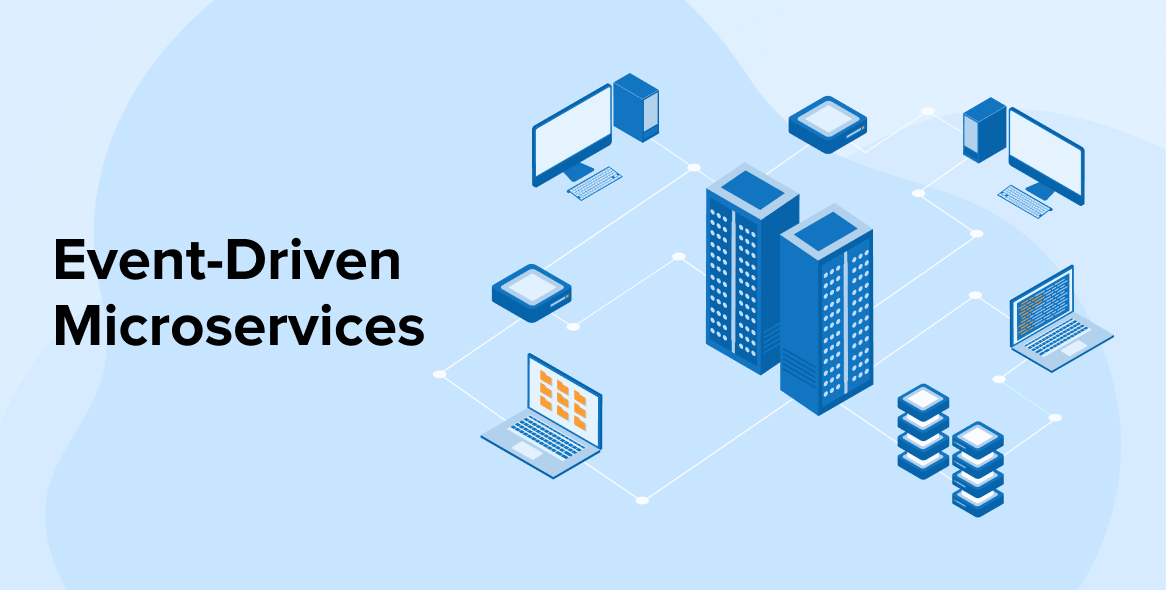
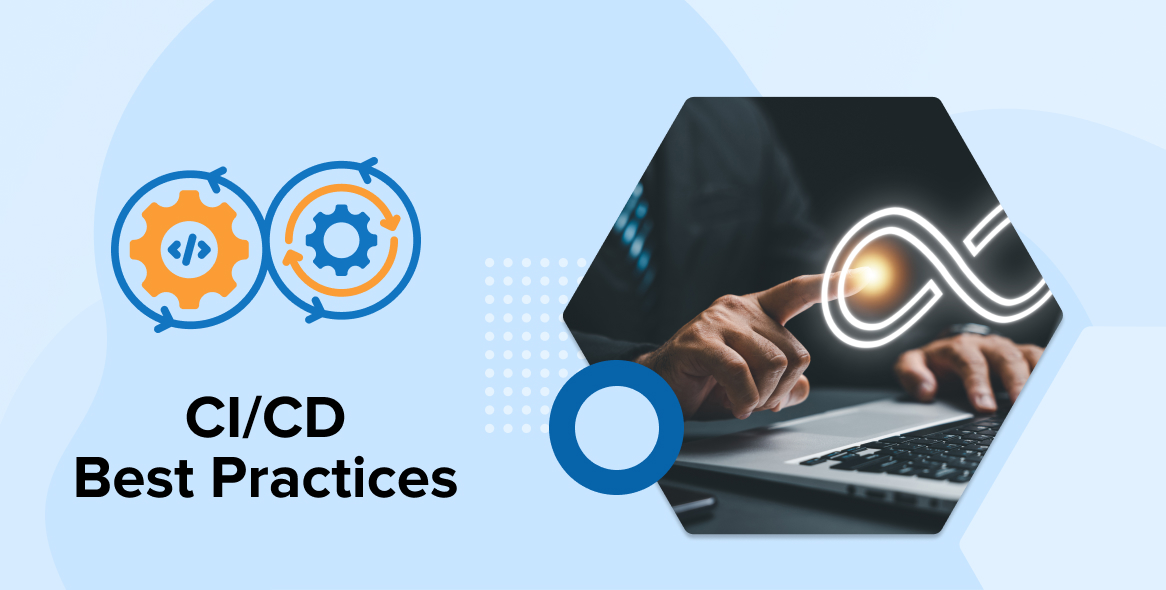
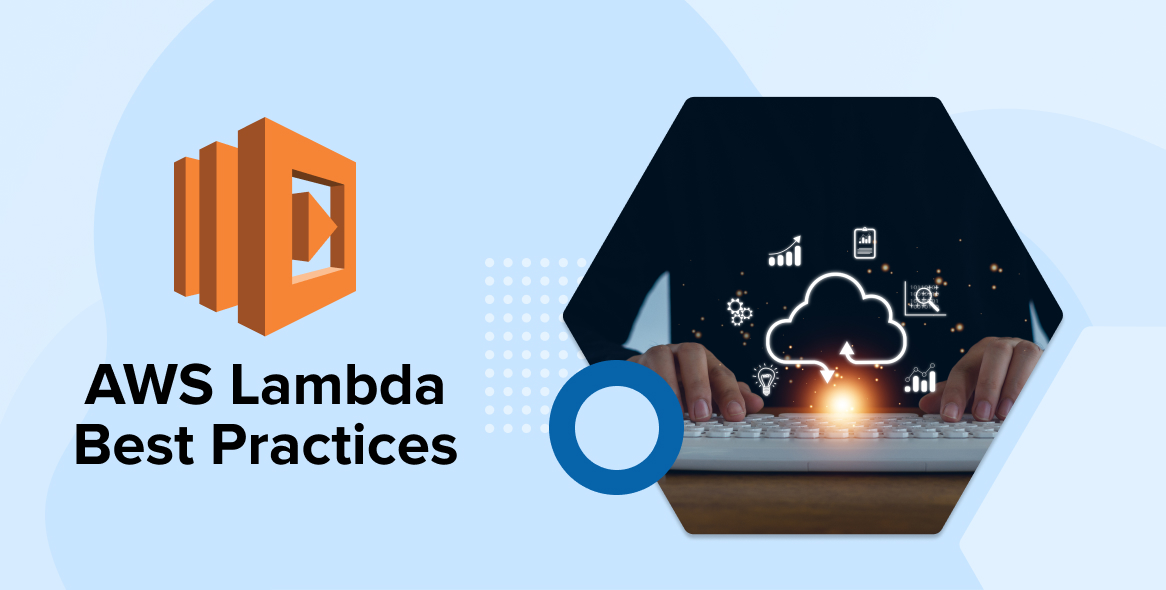

Great explanation of the benefits of microservices for e-commerce! Especially liked the breakdown of challenges and use cases.